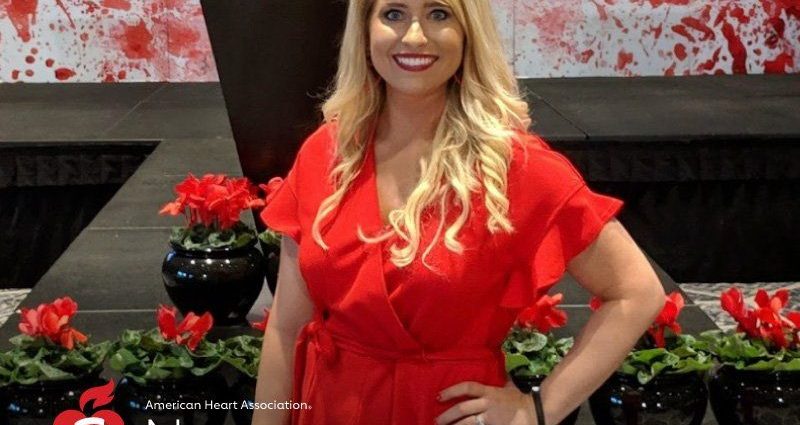FRIDAY, April 7, 2023 (American Heart Association News) — Heather Baker was 28 and a school administrator in Pecatonica, Illinois, when she walked into a conference room for a meeting. She was chatting and joking with her colleagues when she was hit by a sudden wave of nausea.
“The whole room was spinning,” she said.
She tried to tell her colleagues that something was wrong. She wanted to let them know that she might vomit. She tried to move toward the trash can.
Instead, she fell to the ground. She hit her head against the conference table and rolled onto the floor.
She’d gone into cardiac arrest.
Several of her colleagues thought she might be having a seizure, because she was gasping and her body was twitching. Not Bill Faller, her school district’s superintendent. He’d gone through CPR training the month before and knew exactly what to do.
Faller started chest compressions while the school psychologist, who was eight months pregnant, ran for an automated external defibrillator, or AED. She was back in less than a minute.
Middle school principal Tim King walked into the room about that time. As a volunteer firefighter, he was trained to help. He used the AED to try restoring a normal rhythm. Her heart didn’t respond. After a series of compressions, he did it again. More compressions, then a third use of the AED. It produced a sustainable rhythm.
At a hospital, doctors placed her into a medically induced coma. When she woke up the next morning, she heard the story of what had transpired. Her doctors told her just how remarkable her story was.
They’d never seen a 28-year-old experience cardiac arrest. Regardless of age, only about 10% of people survive cardiac arrest outside of a hospital.
“CPR saved my life,” Baker said.
She had no known preexisting conditions or warning signs. She’d been an athlete all her life, playing varsity softball in high school, alongside being a member of the cheerleading team and the drum major of the marching band. She continued going to the gym nearly daily as an adult. She said colleagues would describe her as “vivacious, energetic and talkative.”
Her medical team suspected a medication she was taking for migraines might have contributed, as it depleted her potassium. Still, no one knows for sure why her heart stopped.
Baker feels grateful that she was in the right place at the right time, especially since she grew up hearing about her grandfather, who was not as fortunate. He was driving home from work late at night when his heart stopped. He hit a building with his car and died. He was 50.
“Nobody was around to administer CPR,” said Terry Kole, Baker’s mother.
“I was always disappointed that I missed out on having an amazing grandfather,” Baker said. “Reflecting on his incident after my own reminded me of how lucky I was that I was not alone when my cardiac arrest happened.”
Baker is using her second chance in life to train others in the essential skills that kept her alive.
And, she’s doubled down on her efforts now that she’s the mother of a newborn with a heart condition – a right ventricular aneurysm. Her son’s condition was caught and diagnosed through a fetal echocardiogram at 27 weeks after an ultrasound detected an abnormality with his heart. Baker underwent additional testing throughout her pregnancy due to her health history.
Doctors don’t think genetics are a factor in her son’s condition. They believe it’s another extremely rare case, like Baker’s own heart scare. She’s approached her son’s heart health like her own – with extra diligence, a degree of surrender to what she can’t control and a determination to focus on what she can.
“I am more motivated than ever to make schools and communities safer, knowing that I will be sending my son out into the world,” she said.
Baker has trained nearly 3,000 people in CPR since her own heart scare in 2018.
She’s co-chair of the policy committee of her local office of the American Heart Association, and is a founding member of her local chapter of Project ADAM, a nonprofit that works to increase access to AEDs and CPR training in schools.
Baker now lives in Rockton, Illinois, and is an elementary school principal in nearby Winnebago. She brought her heart health advocacy to that position when she started in 2020. She’s made sure her school trains staff and teachers in CPR and AEDs, educates students about heart health, has a cardiac response plan and practices responding to an emergency. Doing so helped her school become the third school in Illinois to receive a Heart Safe School designation through Project ADAM.
Baker got an AED for her home in case of an emergency. Kole asks every business that she goes into if there’s an AED on hand, like the repair shop that recently worked on her car.
“How do you possibly thank someone who saved your child’s life?” she said. “The only thing you can do is educate others and share the importance of CPR training and AEDs.”
American Heart Association News covers heart and brain health. Not all views expressed in this story reflect the official position of the American Heart Association. Copyright is owned or held by the American Heart Association, Inc., and all rights are reserved.
By Emily Halnon, American Heart Association News
Copyright © 2025 HealthDay. All rights reserved.

